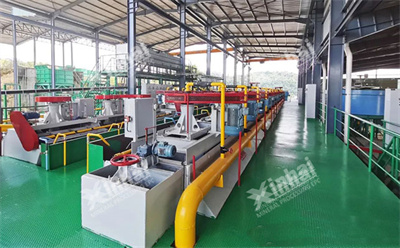Copper oxide ore has significant economic value in mineral resources. The main copper minerals contained in oxidized copper ore include malachite, chalcopyrite, chalcopyrite, etc. These minerals often appear in the form of fine particles, thin films, or soil. In addition to copper oxide minerals, there may also be vein minerals such as quartz, feldspar, mica, and calcite in the ore. At present, the flotation of copper oxide ore is mainly divided into two methods: direct flotation and sulfide flotation.

The significant feature of direct flotation method is that no activator is added, and a collector is directly added to flotation copper minerals. According to the different properties of the collectors used, they can be divided into fatty acid flotation method, amine flotation method, and emulsion flotation method. However, this method has poor selectivity for the target mineral, which to some extent limits its widespread application in the beneficiation of oxidized copper ore.
Fatty acid flotation
Fatty acid flotation uses fatty acid collectors such as oleic acid, linoleic acid, linolenic acid, etc. Under specific pH conditions, these collectors interact with the surface of copper oxide minerals, making the mineral surface hydrophobic and able to be captured by flotation bubbles. For oxidized copper ore containing siliceous gangue, this method has certain selectivity. For example, in a certain copper oxide mine, the fatty acid flotation method was used to successfully recover some copper oxide minerals from ore containing siliceous gangue by precisely controlling the pH value, improving the copper recovery rate.
Amine flotation
Amine flotation uses amine collectors such as dodecylamine, octadecylamine, etc. Under acidic conditions, these collectors bind to the surface of copper oxide minerals through electrostatic adsorption, making the mineral surface hydrophobic and achieving flotation. In practical applications, it is necessary to adjust the acidic conditions according to the specific properties of the ore to achieve the best flotation effect.
Emulsion flotation
Emulsion flotation is the process of mixing an insoluble oil, such as kerosene, diesel, etc., with water and surfactants to form a stable emulsion. Then add this emulsion to the slurry of oxidized copper ore. During the flotation process, oil droplets in the emulsion selectively adsorb onto the surface of copper oxide minerals, making the mineral surface hydrophobic and allowing it to be captured and floated by flotation bubbles. This method has shown good results in the flotation of certain types of copper oxide ores.
When sulfide flotation copper oxide, it is necessary to add a sulfurizing agent before adding a collector to sulfide the copper oxide mineral, so that the difficult to float copper oxide surface can be sulfided to form a copper sulfide thin film layer with good floatability. During the flotation process, the hydrophobic copper sulfide film formed by the sulfurizing agent on the surface of copper oxide minerals can adsorb the collector, thereby allowing the copper oxide minerals to be recovered by flotation. According to different sulfurization methods, it can be divided into conventional sulfurization flotation method, hydrothermal sulfurization flotation method, heated sulfurization flotation method, segmented sulfurization flotation method, etc.
Conventional sulfide flotation
Conventional sulfurization flotation first adds an appropriate amount of sulfurizing agent to the slurry, allowing the sulfurizing agent to undergo a chemical reaction with the surface of copper oxide minerals, forming a sulfurization film on the mineral surface, making the surface properties of copper oxide minerals similar to those of copper sulfide minerals. Then add conventional copper mineral collectors, such as yellow medicine, black medicine, etc. The collector interacts with the surface of sulfurized copper oxide minerals to make them hydrophobic, allowing them to be captured and floated by flotation bubbles. This method has been widely used in many copper oxide mines, and by controlling the dosage of sulfurizing agents and collectors reasonably, the recovery rate of copper can be effectively improved.
Hydrothermal sulfide flotation
Hydrothermal sulfide flotation refers to the method of using SO₂ or sulfur powder as an activator for copper oxide minerals under hot pressure conditions, to sulfide difficult to float copper oxide minerals into easily floating copper sulfide minerals, and then using conventional copper sulfide collectors for flotation. This method has a good effect on some difficult to process oxidized copper ores, which can improve the floatability of minerals.
Heating sulfurization flotation
Heating sulfidation flotation is the process of heating the ore slurry before or simultaneously with the addition of sulfidizing agents for sulfidation treatment of copper oxide ore. After heating and sulfurization treatment, a collector is added for flotation. Heating can promote the sulfurization reaction, improve the sulfurization effect, and thus increase the flotation recovery rate of copper oxide minerals.
Segmented sulfurization flotation
Segmented sulfurization flotation divides the sulfurization process into multiple stages. At different stages, control the amount of sulfurizing agent, sulfurization time, and slurry conditions. For example, a small amount of sulfurizing agent can be pre sulfurized first, followed by main sulfurization, or sulfurization treatment can be carried out separately in different flotation operations. This method can control the sulfurization process more finely and improve the flotation efficiency of copper oxide minerals.
The flotation process and method of oxidized copper ore are of great significance for improving the recovery and utilization of copper resources. The direct flotation method and sulfide flotation method each have their own characteristics and applicable scope. In practical applications, it is necessary to select appropriate flotation methods and process parameters based on the specific properties of oxidized copper ore, such as mineral composition, particle size distribution, and mud content. At the same time, continuously exploring and innovating flotation technology to improve the flotation efficiency and recovery rate of oxidized copper ore is of great practical significance for ensuring the sustainable supply of copper resources.